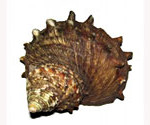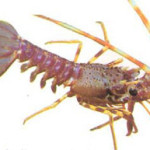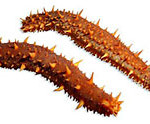
Haliotis spp. – 4 species
Abalones are highly-valued but slow growing, herbivorous marine snails. They belong to a large class of molluscs (Gastropoda) with single-structured shells. There are over 100 species worldwide in the single genus Haliotis, which means ‘sea ear’, a reflection of the flattened shape of the shell. It is no surprise then that it is called ‘Oreille de Mer’ in France. Abalone shells can be oval or rounded, with a row of respiratory pores and large dome towards one end. They are edible molluscs and considered a delicacy. The inner shell of abalone, which has an iridescent green, blue, or pink sheen, is a source of mother-of-pearl
The strong, muscular foot generates enough suction to allow the abalone to fix itself firmly to rocky surfaces, and enables it to withstand the strong buffeting of the waves. They are found from the intertidal to the depth limit of marine plants, some 80 -100m, from tropical to cold waters. They feed mostly on seaweed, which they trap by marginally raising the front end of the ‘foot’, and when a piece of seaweed drifts underneath, the foot clamps down on it.
Worldwide there are approximately 100 species of abalone, of which about 15 are harvested commercially. Demand for this delicacy has outstripped the natural supply, with a resulting growth in mariculture. The principal countries producing cultured abalone are China, Taiwan and Japan. Several other countries including Australia, Chile, Iceland, Ireland, Mexico, New Zealand, South Africa, Thailand, and the United States are still developing significant abalone mariculture industries. The story of depletion of the ocean’s abalone stocks is not encouraging in all of these countries, with reductions running from 50 to 95 percent in the commercial catch over the past twenty quarter century.
Called awabi in Japan, there are a number of species to be found in the waters of the region. In Japan alone there are 10 species, of which only four constitute staple food products. Despite a large volume of imported species for local markets, there is a distinct preference in Japan for a local Japanese green abalone called ezo awabi (Haliotis discus hannai), the only species eaten live locally.
This species is found in the more southerly part of the region, and is similar to the more northerly kuro awabi (Haliotis discus discus). Feeding on brown algae, they are on or under rocks from the inter-tidal zone to about 20m, the shell grows to 15cm, with 4-6 open, nearly circular perforations, with a spiral groove to the right of the perforations. Of the total catch ezo hawabi supplies 58%.
The giant abalone (Haliotis gigantea) grows to 200mm. The shell has a tinge of iridescent shades of blue, green and bronze. Any pearls that the animal produces as a reaction to irritants within the shell have the same colour range. The species Haliotis sieboldii grows to 150mm.








Social Profiles